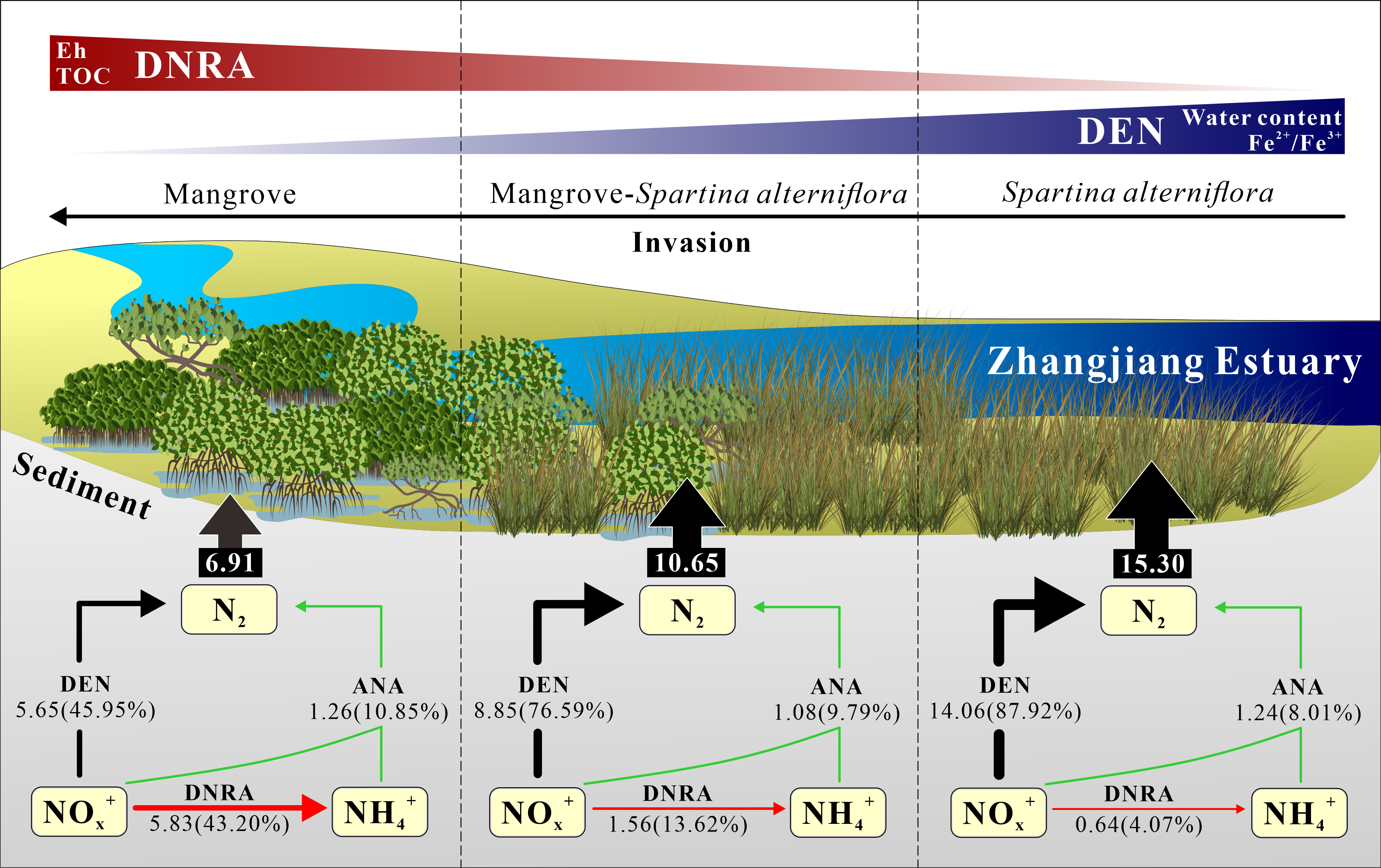Wide and rapid Spartina alterniflora invasion has threatened the sustainability of coastal wetlands of China, and has a significant impact on sediment biogeochemical cycle. It also invaded mangrove wetlands, which are the most productive ecosystems. Mangrove can also alleviate the eutrophication in estuaries and coasts due to the highest nitrogen (N) use efficiency and nutrients reabsorption efficiency among angiosperms.
Previous studies have founded the Spartina alterniflora invasion induced changes in sediment N-cycling compared to native communities, including increased sediment N accumulation and improved N fixation rates. It has also been reported that Spartina alterniflora invasion increased N loss in Scirpus mariqueter and Phragmites australis sediments. Sediment effects of Spartina alterniflora invasion in N-cycling are different for different native species. Accurate estimation of the N-loss and N retention fluxes in coastal wetland sediment is necessary to understand N transformation and fate, and provide a basis for controlling plant invasion and N pools.
Among dissimilatory nitrate (NOx−) reduction processes, denitrification (DEN) and anammox (ANA) generally reduce the inorganic N to N2, resulting in the N loss. In contrast, dissimilatory nitrate reduction to ammonium (DNRA) reduces NOx− to NH4+, retaining the N in the environment. Therefore, we used 15N isotope tracing technique combined with MIMS to determine sediment DEN, ANA and DNRA to reveal related N cycling processes and mechanisms. Also, contributions (DEN%, ANA%, and DNRA%), associated functional genes (nirS, anammox 16S rRNA and nrfA) and controlling factors were investigated in surface sediments (0−5 cm) in mangrove and Spartina alterniflora communities and ecotone of the Zhangjiang Estuary, China.

Figure 1: Sediment NOx− reduction rates (μmol kg−1 h−1) and relative contributions of each pathway to total NOx− reduction along three types of plant community. The values are averages for summer and winter.
Significant spatial differences in DEN, DNRA, DEN%, and DNRA% were found among different plant communities (p < 0.05 for all). DEN is the dominant pathway of NOx− reduction processes in Spartina alterniflora community (87−89%) and ecotone (75−78%), while DEN (41−51%) and DNRA (36−51%) compete with each other in mangrove community. Organic matter was the most dominating factor controlling DEN and DNRA rates, and Spartina alterniflora invasion may reduce sediment organic matter concentrations and microbial community abundances. Without accounting for confounding factors, Spartina alterniflora invasion significantly reduced the nitrogen retention index (NIRI), causing a large amount of N loss in wetlands. N-loss rates in Spartina alterniflora (15.30±0.57 μmol kg−1 h−1) was higher than that in the ecotone (10.65±0.33 μmol kg−1 h−1) and mangrove community (6.91±0.28 μmol kg−1 h−1). We estimated that Spartina alterniflora invasion has increased sediment N-loss (831.09±55.16 t N yr-1) but reduced N retention (783.48±37.73 t N yr-1) in mangrove habitats of China within last 40 years (1980−2020). Thus, Spartina alterniflora invasion enhances sediment N-loss while reducing N retention in mangrove wetlands, which may threaten the mangrove buffer function and wetland N pools protection in estuarine and coastal ecosystems.
 Project summary by: Xianbiao Lin, Frontiers Science Center for Deep Ocean Multispheres and Earth System, and Key Laboratory of Marine Chemistry Theory and Technology, Ministry of Education, Ocean University of China, Qingdao 266100, China
Project summary by: Xianbiao Lin, Frontiers Science Center for Deep Ocean Multispheres and Earth System, and Key Laboratory of Marine Chemistry Theory and Technology, Ministry of Education, Ocean University of China, Qingdao 266100, China
Paper Reference: Bin wang, Xianbiao Lin “Exotic Spartina alterniflora invasion enhances sediment N-loss while reducing N retention in mangrove wetland” Geoderma (2023) 431, 116362 DOI: 10.1016/j.geoderma.2023.116362
Hiden Product: HPR-40 DSA
Download PDF: AP-HPR-40-202176
To find out more about these products visit the HPR-40 DSA product page or if you would like to contact us directly please Send us a Message.

